

Critical Thinking Worksheets

A Total Of 15

Connect The Dots

Count The Squares

Proving Your Belief

What You Learned

Choose A Prompt

Narrative Parallels
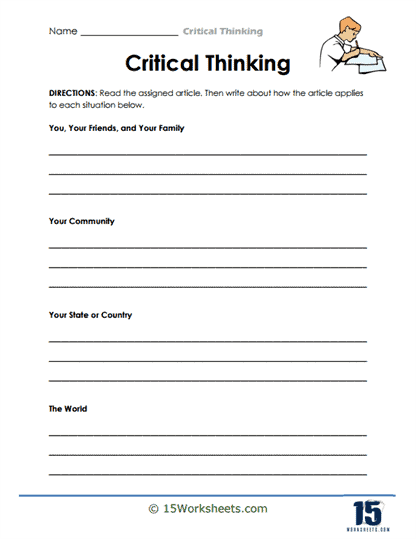
Real-Life Applications
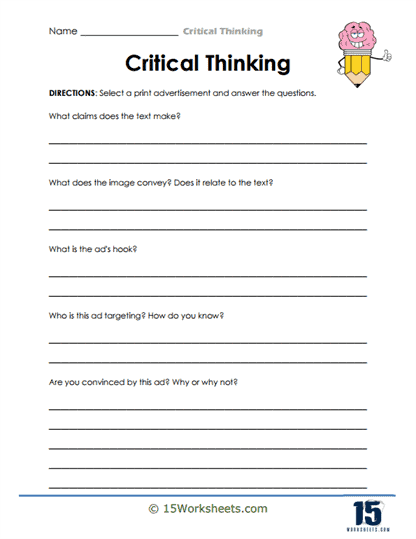
Dissecting A Print Ad
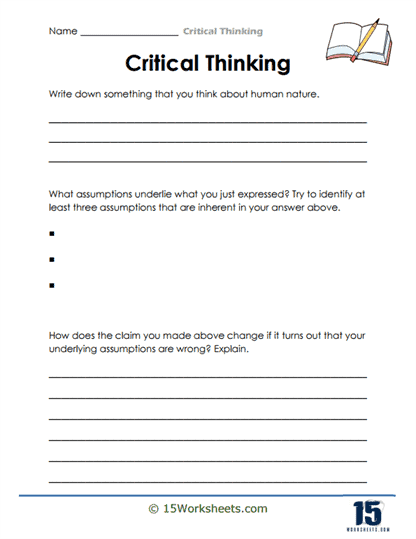
A Philosophical Inquiry
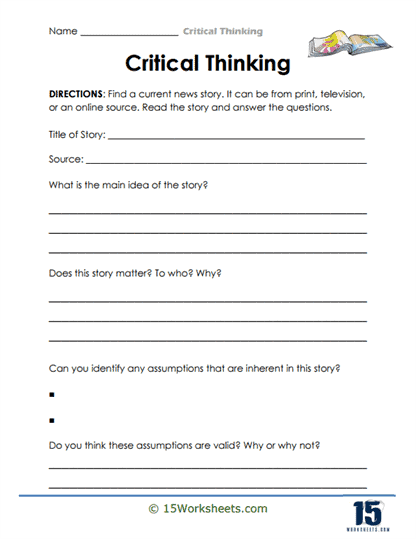
Beyond The Surface

Simplify The Problem
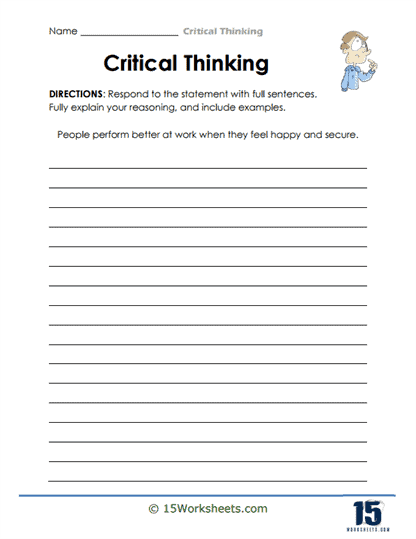
Explain Your Reasoning
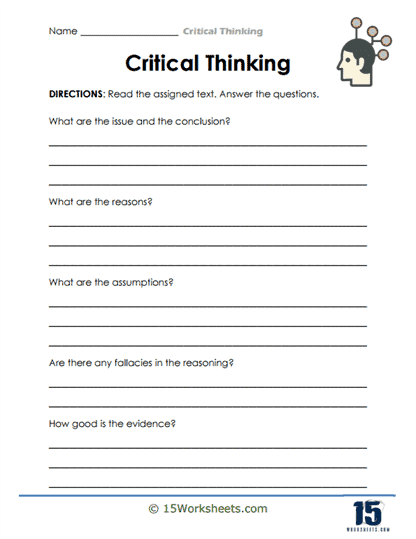
Looking For Fallacies
About these 15 worksheets.
Critical thinking is one of the most essential skills a person can develop. At its core, it involves the ability to analyze, evaluate, and synthesize information in a way that goes beyond surface-level understanding. It’s about engaging deeply with ideas, weighing evidence, and considering multiple perspectives before forming conclusions. In a world that is constantly bombarding us with information, critical thinking acts as a compass, guiding us through the complexities of knowledge and helping us make well-informed decisions in every aspect of life.
The purpose of critical thinking worksheets is to serve as a practical tool to sharpen this vital skill. These worksheets are more than just sheets of paper filled with activities-they are structured exercises that challenge your mind to think more deeply. Through engaging prompts, questions, and scenarios, learners are encouraged to dive into higher-order thinking. The goal is not just to find answers, but to explore the process of how those answers are reached, and to develop a strong sense of reasoning. Whether you’re solving a problem, analyzing an argument, or making a decision, critical thinking worksheets provide a framework to think systematically and thoughtfully.
Imagine these worksheets as tools for your brain, much like how weights are used to build physical strength. They force you to push your mental limits, exploring various ways of thinking and finding solutions to complex challenges. Just as you might approach a puzzle, critical thinking exercises invite you to consider different angles, ask probing questions, and seek out the best possible answers. This deliberate practice strengthens your cognitive abilities over time, making you more adept at navigating difficult questions and scenarios, both in the classroom and beyond.
When you train your brain to think in new and different ways, something extraordinary happens-learning becomes more dynamic and engaging. Instead of memorizing facts or relying on rote answers, you begin to connect ideas across subjects. You start noticing patterns and relationships between concepts that previously seemed unrelated. For instance, a lesson in science might suddenly shed light on a historical event, or a math problem could lead to a deeper understanding of a concept in economics. Critical thinking turns the learning experience into a rich web of interconnected ideas, where every piece of knowledge you gain adds depth to your overall understanding.
This transformation in thinking is akin to becoming a detective. Like a detective solving a mystery, critical thinking encourages you to gather evidence, evaluate it carefully, and draw conclusions based on sound reasoning. You develop a mindset that is curious, inquisitive, and always searching for the next clue. Instead of passively accepting information, you actively question it. Why does this fact matter? How does this concept relate to what I already know? What are the possible implications of this argument? These are the kinds of questions critical thinkers ask themselves regularly.
In fact, one of the most powerful benefits of critical thinking is that it helps you become a more independent thinker. Rather than relying on others to tell you what to think, you learn to trust your own reasoning abilities. You develop confidence in your ability to assess situations and make decisions based on logic and evidence. This skill is invaluable not only in academic settings but also in everyday life. Whether you’re deciding what career path to pursue, evaluating the credibility of news sources, or resolving personal conflicts, critical thinking empowers you to approach these situations with clarity and purpose.
Types of Exercises
Comparing and Contrasting
These exercises will have you look at two things and find out how they’re the same or different. For example, you might get pictures of a cat and a dog. You’ll write down how they are alike (like both have tails) and how they’re different (like dogs usually bark, and cats meow).
Cause and Effect
These activities make you think about what might happen because of something else. Imagine if you saw a picture of a melted ice cream cone on the sidewalk. The worksheet might ask, “Why did the ice cream melt?” You’d think about the reasons, like maybe it was a hot day.
These exercises will ask you to put things in order. Let’s say you get pictures showing a seed, a young plant, and a big tree. Your job would be to put them in the right order, from the seed growing up to the tree.
Predictions
With these, you’ll guess what might happen next. Maybe there’s a story about a boy who’s holding an umbrella while looking at dark clouds. The worksheet might ask, “What will he do next?” And you’d guess, “He’ll open the umbrella because it might rain.”
Problem and Solution
Here, you’ll read about a problem and think of ways to solve it. Like, if there’s a story about a girl who keeps losing her pencils, you might suggest she gets a pencil case.
Riddles are fun questions or puzzles that make you think hard. An example of a riddle is, “What comes down but never goes up?” The answer? Rain!
Grouping and Categorizing
In these activities, you’ll put things into groups based on how they’re alike. For example, you might get pictures of a car, a bicycle, a fish, and a boat. You’d group the car and bicycle together because they’re ways to travel on land. The fish and boat can be grouped as things related to water.
Making Connections
This helps you link what you already know to new things. If you read a story about a girl who’s sad because her balloon flew away, you might remember a time you felt sad and understand how she feels.
Ask Questions
Some worksheets will have a story or picture, and then you’ll come up with questions about it. Like, if there’s a picture of a forest, you might ask, “What animals live there?” or “Why are forests important?”
How to Help Foster Student Critical Thinking Skills
Improving critical thinking skills in students is a fundamental role of educators, as these skills equip students to analyze, evaluate, and synthesize information in a reasoned manner. To begin with, teachers should cultivate a classroom environment that values questions over answers.
Encouraging students to ask “why” and “how” helps them delve deeper into topics and challenges their preconceived beliefs. Incorporating problem-based learning into the curriculum is another effective approach. By presenting students with real-world problems, they learn to apply their knowledge, analyze situations, and come up with solutions.
Regularly engaging students in debates or discussions on diverse topics can also sharpen their ability to think on their feet, consider different viewpoints, and defend their perspectives with evidence. Furthermore, teachers should emphasize the importance of reflection. After tasks or discussions, providing opportunities for students to reflect on their thinking process can foster self-awareness of their cognitive habits.
Assigning projects that require evaluating information from various sources also helps. In a digital age where misinformation is rampant, teaching students to discern credible from non-credible sources is crucial.
Promoting metacognition-thinking about one’s thinking—can be transformative. By making students conscious of their thought processes and guiding them in recognizing biases, assumptions, or logical fallacies, educators empower them to become more discerning and independent thinkers. In essence, fostering critical thinking is about providing students with tools to think clearly and rationally, equipping them for challenges both inside and outside the classroom.
Trending Post : Impulse Control Activities for Kids


36 Fun Critical Thinking Games and Activities for Kids (Printable)

Critical Thinking Games & Activities for Kids: Critical thinking skills are widely recognized as essential to equip children for learning, in and outside the classroom, and for modern life. In this post, we will explore what critical thinking means, why it is so important, and how to help build these skills in children with 36 fun critical thinking activities. You will also be able to download a free worksheet with some of the activities mentioned in the post.
Table of Contents
- What is critical thinking?
- Why are critical thinking skills important?
- How can we help build the skills and mindset for critical thinking?
- 36 Fun critical thinking activities for kids
- Critical thinking worksheets download
What is Critical Thinking?
We all know more or less what critical thinking is. So it may surprise you to know that there is no one standard, agreed definition. US philosopher and educator John Dewey first developed the concept in the early 20th century, although he more commonly used the term “reflective thinking”, defined as:
“Active, persistent, and careful consideration of any belief or supposed form of knowledge in the light of the grounds that support it and the further conclusions to which it tends.”
The Reboot Foundation provides a simpler, more contemporary definition:
“We define critical thinking broadly, and we believe it is a type of reflective thought that requires reasoning, logic, and analysis to make choices and understand problems.”
Most experts agree that there are two dimensions to critical thinking:
- Skills, or abilities which can be taught ( such as analysis, inference, evaluation, self-regulation).
- Dispositions, or attitudes, which can be developed ( such as being open-minded, fair-minded, suspending judgement, inquisitiveness).
Skills can be more straightforward to teach, and to measure, than dispositions. But critical thinking skills and dispositions are mutually reinforcing, and should be built together.
One way to explain how critical thinking differs from simply acquiring knowledge is through “Bloom’s Taxonomy”, developed in 1956, and revised to the version below in 2001. The Taxonomy separates out simple memorization of facts, at the base of the pyramid, from the tasks which require progressively more reasoning and reflection: understanding, applying and analyzing knowledge, critically evaluating it and, ultimately, creating new, original work.

Armstrong, P. (2010). Bloom’s Taxonomy. Vanderbilt University Center for Teaching. Retrieved 22 October 2024 from https://cft.vanderbilt.edu/guides-sub-pages/blooms-taxonomy/ Used under a Creative Commons Attribution license.
Why are Critical Thinking Skills Important?
Dewey’s work on critical thinking helped to transform education, from a system built around rote-learning, memorization and repetition of learned facts, to a system which values students’ ability to think for themselves.
Now, critical thinking skills provide an essential basis for future learning. But critical thinking is important for so much more, beyond the classroom.
Long before the internet or social media, critical thinking was seen as important for the health of democracy.
Now it is recognized as a “ 21 st century skill ” – the set of abilities and knowledge that are essential for individuals to thrive in the modern world.
When we think about children growing into teenagers, and encountering the tsunami of information, misinformation and disinformation directed to them through social media, equipping our children to grow up as critical thinkers is an essential life skill.
How Can we Help Build the Skills and Mindset for Critical Thinking?
The abilities and attitudes necessary for critical thinking begin to develop early . By as early as age 3, children understand that people sometimes communicate inaccurate information, and that some individuals are more reliable sources than others.
And the critical thinking journey never really stops: it is part of early childhood education, throughout the school years, life outside the classroom, and at the university level, where critical thinking can be essential to success.
We have seen that critical thinking is about both skills and mindset. The best way to support critical thinking is to work on both acquiring the skills necessary for critical thinking (e.g. analysis, inference, evaluation, self-regulation), and encouraging the attitudes needed to think critically (e.g. being open minded, fair minded, and curious).
This can be practiced in the learning of subject matter across all subjects, and beyond the classroom, in day to day life. The more that children ask “why?”, the more opportunities there are to support them in their critical thinking journey.

36 Fun Critical Thinking Games and Activities for Kids
Now that we have reflected on what critical thinking is and why it is so important for cognitive development, let’s jump in and start practicing a whole set of engaging and fun activities to help children strengthen these skills and develop a critical thinking mindset.
These activities can be used as building blocks and inspiration, in the classroom and at home. They can be woven in to wider learning, or used as creative ideas to have family conversations at the dinner table.
Fun Simple Critical Thinking Activities for Kids
1. Sorting Objects
Strengthen logical reasoning by encouraging kids to classify items based on attributes like size, color, or shape, helping them identify patterns and make connections.
For example, ask children to sort a group of buttons of different colors, sizes, and shapes, and then explain the reasoning behind their sorting criteria.
2. Count and Analyze Patterns
Use colored beads to create sequences (e.g., red, blue, red, blue) and ask children to predict what comes next, or to create their own repeating patterns.
3. Find the Odd One Out
Present a group of objects like a banana, an apple, a car, and ask children to identify which one is the odd one out and explain why.
4. Who Am I?
A child thinks of an object, and the others ask yes/no questions to figure it out, such as “Is it something you find outside?” or “Can you eat it?”
5. “What If?” Questions
This type of game encourages curiosity and deeper thinking by exploring open-ended questions, much like the Socratic method, encouraging students to reason and arrive at their own conclusions.
Ask children questions such as:
- What if animals could talk? How would that change our relationship with them?
- What if there were no rules? What do you think society would look like?
- What if everyone had the same job? How would our world look?
6. Story-building with Critical Questions
- Example : Build a short story with a problem, like “The dog is lost,” and ask children to discuss the cause, what steps can be taken to find the dog, and the potential outcomes.
7. Problem-Solving Storybooks
You can use your usual classroom activities and turn them into problem-solving activities. For example, if you’re reading a book like The Three Little Pigs , you can pause to ask, “What would have happened if the pigs had built their house differently?” This encourages kids to analyze decisions in the plot and think critically about alternative outcomes.
8. Reviewing Evidence (Detective Games)
Create a detective game where children review evidence (footprints, letters) to figure out “who ate the cookies” or another mystery, requiring logical deduction.
Critical Thinking Games & Brain-Teasers
9. Memory Card Games / Matching Card Games
Memory card games are classic games in which children flip over cards to find matching pairs.
Although memory games are more clearly associated with memory skills, they can also support critical thinking by encouraging attention to detail, pattern recognition, and strategic recall of card locations to match pairs efficiently.
For example, instead of flipping cards randomly, kids could start by lifting cards from left to right in each row. This structured approach can help them remember the sequence and location of cards, making it easier to spot matches when a similar card appears later. By developing this strategy, they’re not only improving their memory but also practicing critical thinking through planning and pattern recognition.
10. Scavenger Hunts
To turn a scavenger hunt into a critical thinking activity, add clues that require kids to solve puzzles, interpret riddles, or make inferences to find each item.
For example, instead of simply listing an umbrella, provide clues like “I’m something that keeps you dry in the rain, and you hold me above your head”. You could also add challenges where kids must categorize the items they find by characteristics (like color or texture) or answer questions about why each item might be useful in different situations.
This approach encourages problem-solving, inference, and categorization skills throughout the hunt.
11. Mystery Bag Game
A Mystery Bag game encourages kids to use their senses and deduction skills to identify hidden objects. Place various items in a bag and allow kids to feel each one without looking, prompting them to guess what it is based on texture, shape, or weight. They can ask yes-or-no questions to narrow down possibilities (e.g., “Is it soft?”, “Is it something I can eat? or “Is it something we use every day?”).This activity fosters critical thinking by requiring kids to analyze clues, make inferences, and refine their guesses, enhancing their problem-solving abilities.
12. Puzzle Solving
Puzzles can boost logical thinking and problem-solving skills by encouraging kids to find solutions through trial, error, and reasoning.

13. Sudoku (Simple)
Sudoku is another great puzzle game that promotes logic, pattern recognition, and problem-solving for children of all ages.
The game can be tailored to various skill levels, making it suitable for all ages: the easiest grids start with a 4×4 layout, perfect for younger kids who are just beginning to explore logical reasoning.
For a fun twist, you don’t even need to use numbers! Simple shapes or colors can replace numbers to create a kid-friendly version, allowing younger children to solve puzzles with familiar objects while developing their reasoning skills.
I’ve included a fun, simple Sudoku activity in your download at the end of this post that younger kids will love.
14. Mystery Number Games
Give a series of clues, like “I’m thinking of a number between 1 and 10, and it’s not even,” and have children ask questions to deduce the number.
15. Logic Riddles or Brain Teasers
Riddles and Puzzles are a fun way to present a mental challenge to kids. They are widely available in puzzle books and logic activity books for children.
Examples of riddles:
- “What has keys but can’t open locks?” and have children reason out the answer by thinking about the word “piano.”
- “I speak without a mouth and hear without ears. I have no body, but I come alive with the wind. What am I?” (this one is echo, in case you didn’t guess it)
16. Lateral Thinking Puzzles .
Lateral thinking puzzles are puzzles designed to challenge traditional thinking patterns by encouraging creative, outside-the-box solutions. Instead of straightforward logic, these puzzles require unconventional reasoning and unique perspectives, pushing kids to think beyond obvious answers.
For example, a lateral thinking puzzle might present a scenario where only by reinterpreting or reframing details can the solution be found, such as:
- “A man walks into a town on Friday, stays for three days, and leaves on Friday. How is this possible?”(Answer: The man’s horse is named Friday.)

17. Logic Grid Puzzles
Logic grid puzzles are brain-teasers that involve filling in a grid based on a set of clues to determine relationships between different categories or items.
For instance, you might have a puzzle about three friends, each with a different pet, favorite color, and favorite food. Using the clues provided (e.g., “The person with the cat doesn’t like pizza”), you can eliminate possibilities and make connections until all categories align correctly.
These puzzles develop critical thinking and deductive reasoning skills, as solvers must analyze the clues, make inferences, and systematically rule out options to find the solution.
Your free Critical Thinking Worksheets download, at the end of this post, also includes an example of a logic grid puzzle.
18. Maze Challenges
Provide a printed maze and ask children to solve it by choosing the correct path, discussing their strategy for avoiding dead ends and reaching the goal.
Our next two activities are classic strategy games that promote strategic planning and evaluation:
Chess is a timeless game of strategy, widely available both digitally and physically in educational formats. Set up a chessboard and teach children the basic moves, then have them play a game where they practice planning several moves ahead, anticipating their opponent’s strategy.
20. Checkers
Checkers is another, simpler strategy board game. Play a simple game of checkers with a child, encouraging them to think one or two moves ahead to capture pieces and block their opponent.
21. Role-Playing Games
Role-playing games (RPGs) are games where players assume the roles of specific characters, often in a fictional or fantastical setting, and make decisions that shape the story or world around them. In RPGs, players use imagination and creativity to develop characters with unique abilities, personalities, and goals, often collaborating to solve challenges or quests.
There are different types of RPGs, such as:
- Tabletop RPGs (e.g., Dungeons & Dragons ), where players narrate actions and decisions guided by a game master.
- Live-action RPGs (LARPs) , where players physically act out their characters’ actions.
- Video Game RPGs (e.g., Final Fantasy , – although note that while previous editions have been mostly young teen-friendly, some editions are rated M / R13. For fully kid-friendly video RPGs, you check out Starport or Kids on Bikes.
RPGs, like tabletop and video game formats, can be safe and valuable for teaching critical thinking, teamwork, and creativity, with a few guidelines:
- Age-Appropriate Content : Choose RPGs with themes and language suitable for the classroom.
- Screen Time : Balance video game use with other activities to avoid excessive exposure.
- Safety in Live-Action : For LARPs, set clear boundaries to ensure a safe environment.
- Classroom-Friendly RPGs : No Thank You, Evil! and Rory’s Story Cubes promote storytelling and problem-solving.
- Educational RPGs : Classcraft uses RPG quests to support learning goals and teamwork.
- Simple Role-Playing Activities : Use history or science scenarios to bring content to life through role-play.
22. Escape Rooms
Participating in a escape room activity is an excellent way for older students to practice critical thinking skills. Participants are locked inside a themed room and must work together to solve puzzles, find clues, and accomplish tasks within a given time limit in order to “escape” from the room. Escape rooms are great team-building games and promote critical thinking through:
- Problem-Solving : Players must analyze clues, recognize patterns, and piece together information to advance.
- Logical Reasoning : Each puzzle builds on the next, requiring logical deduction to understand how clues relate.
- Analytical Skills : Players break down complex information, assess details carefully, and synthesize clues to solve each step
- Teamwork : Players need to communicate effectively, share ideas, and build on each other’s strengths to solve complex problems together.
- Time Management : The time constraint encourages quick thinking and prioritizing.
Let’s also explore some educational games and activities!
Critical Thinking Activities for the Classroom
23. Improvised Building Activity (STEM – Science Activity )
Provide children with a box of mixed-up items like straws, paper clips, and rubber bands, and ask them to build a structure that can hold a small toy car, encouraging problem-solving.
24. Guess the Cause and Effect / Scientific Inquiry Activities
Engage kids to explore relationships by predicting outcomes, testing hypotheses, and observing results, strengthening their understanding of cause and effect through hands-on discovery.
Some cause-effect activity examples:
- Sink or Float : Have kids predict whether various objects (like a coin, sponge, or apple) will sink or float, then test each item in water and observe the outcomes.
- Plant Growth Experiment 1 : Plant seeds in different conditions (sunlight vs. darkness or water vs. no water) and have kids guess which plants will grow best, tracking progress over time.
- Plant Growth Experiment 2: Show kids a plant that’s wilting and ask, “What do you think is happening here?” Let them suggest reasons like “It needs water” or “It’s too sunny,” and then test their hypothesis.
- Ball Drop Test : Ask kids to predict which will bounce the highest, a tennis ball, basketball, or a bouncy ball. Then perform the experiment by dropping them from the same height, to see if their predictions were correct.
25. Simple Coding (Logic-Based)
Use a coding game like “Scratch Jr.” to have children sequence blocks to make a character move in a specific direction, reinforcing the concept of logic and order. Some examples of other coding apps for kids are Scratch, Code.org, or Tynker.

26. Facts vs. Opinion (Worksheet)
Fact vs. Opinion activities help kids learn to tell the difference between objective truths and personal viewpoints, which is essential for critical thinking. By distinguishing facts—things that can be proven true—from opinions, which reflect personal feelings or beliefs, kids become better at evaluating information.
These activities teach them to look for evidence, question sources and understand that not everything they hear or read is a fact, which is a valuable skill in everyday decision-making and understanding of the world around them.
You can download a simple Facts vs Opinion activity to add to your critical thinking classroom games at the end of this article.
27. Observation Journals
Observation Journals are a great critical thinking exercise, encouraging kids to record daily observations and reflect on details in their surroundings. This practice sharpens mindfulness, enhances analytical skills, and prompts kids to notice patterns, make connections, and express unique perspectives.
Observation journals can include prompts like, “What did you notice on your way to school?” or “Describe something interesting you saw today.”
This versatile activity can be used for nature walks, scientific observations, or even social settings, making it a fun and educational habit.
28. Simple Flowcharts
Simple Flowcharts are an excellent tool for helping kids visualize steps in a process, enhancing their problem-solving and critical thinking skills.
Creating flowcharts teaches them to break down tasks into manageable parts, understand sequences, make logical connections between actions, and practice decision-making. This exercise can be used for anything from illustrating everyday life routines to mapping out decision-making steps.
This is an example of what a flow chart for “deciding what to do after school” could look like:
- If Yes → Go to Step 2
- If No → Start Homework
- If Yes → Go to Step 3
- If No → Complete Chores
- If Yes → Go Outside
- If No → Go to Step 4
- If Read → Read Book
- If Game → Play Game
29. Problem Solving Activities
Give kids a problem (for example, “How do I fix this broken toy”, and ask them to evaluate different possible solutions, such as glue, tape, or replacing parts.)
Guide them through the problem-solving process:
- Identifying the problem (what has happened?)
- Analyzing the problem (how did it happen?)
- Generating potential solutions or strategies to address the problem.
- Evaluating all possible solutions (Pros and Cons Analysis)
- Selecting the best solution based on their analysis and judgment.
- Implementing the best solution
- Monitoring progress and results
- Reviewing and evaluating the outcomes and making adjustments if necessary.
Other resources: Problem-solving workbook for kids

Debates are a fantastic way to encourage creative thinking and help kids understand different perspectives on real-world problems. By arguing for or against a topic, students learn to consider and respect diverse viewpoints, building skills in critical analysis and the curiosity and flexibility needed for problem-solving.
Divide students into groups, and randomly allocate the teams that will defend either position.
Here’s a list of five debate topics that would work well for a team pro/con structure:
- Should kids have homework every day?
- Would it be it better to have a longer summer break, or shorter school days year-round?
- Should schools ban junk food from the cafeteria?
- Is it better to learn from books or through technology?
- Should animals be kept in zoos?
- Should kids be allowed to have smartphones?
31. Classification Game
Present a set of mixed-up objects (e.g., animals, plants, objects) and ask children to categorize them into specific groups (e.g., mammals, plants, machines).
32. Predicting Changes in an Ecosystem
This activity involves analyzing data or observing patterns to make educated guesses about how an ecosystem might evolve under certain conditions. This can help students understand cause and effect within natural systems, fostering critical thinking about environmental science and ecology.
For example, create a small ecosystem using plants and animals (real or artificial) and ask children what would happen if a new element was introduced, such as removing one species or adding a new one. ed: suggest plants and insects. Creating an ecosystem with animals is a big ask!
33. Making Predictions from Data
Making Predictions from Data is a real-world activity that teaches students to analyze patterns and trends to make informed guesses about future outcomes. By examining data, whether from a simple weather chart or a survey on favorite foods, students learn to interpret information, identify trends, and develop critical thinking skills. This activity can be used in various subjects, helping students understand how data supports decision-making in everyday life.
For example, give students data on the number of books read by their classmates each month. They notice that book reading increased steadily from September to December. Based on this trend, ask them to predict how many books will be read in January and discuss possible reasons for the increase, like cooler weather or reading challenges.
34. Comparing and Contrasting Items
Comparing and Contrasting is a key critical thinking activity that helps students explore similarities and differences between topics, ideas, or items. This skill can be applied to anything from everyday choices to analyzing historical events, comparing characters in a story, or understanding scientific concepts. An effective activity is to have students compare items they might want to buy, like two different backpacks or tablets. By evaluating features, prices, and quality, they practice making informed decisions, building both analytical and decision-making skills.
35. Analyze a News Article
Provide a simple news article on current affairs and ask children to identify the key points of that particular situation, evaluate the reliability of the sources, and discuss what actions they might take if they were involved in the situation. This activity builds critical thinking by encouraging them to reflect on real-world events and consider different perspectives.
36. Make a Decision Matrix
A Decision Matrix is a tool that helps students evaluate multiple options by rating each one based on specific criteria. It’s a grid where options are listed on one side, criteria on the other, and each option is scored to find the best choice. This encourages critical thinking and teaches students to make thoughtful, balanced decisions by considering all aspects of a problem.
- Students are deciding on a class project, they can list options (like a science experiment, art display, or community service) and criteria (interest level, resources needed, time required) to help choose the best fit.
- Families choosing a pet may weigh options like size, cost, care requirements, and activity level.
Incorporating critical thinking activities in the classroom is a powerful way to nurture young minds. These exercises build essential cognitive skills and help kids become inquisitive, confident thinkers.
Other Cognitive Abilities Resources & Articles
- Fun Problem-Solving Workbook for Kids
- 25 Problem-Solving Activities for Kids
- 57 Memory Activities for Kids
- 30 Focus & Attention Activities for Kids
Critical Thinking Worksheets for Kids (PDF Download)
Your critical thinking worksheets include the following activities:
- Fun Shapes Sudoku
- Fact vs Opinion
- Debate Activity
Similar Posts

101 Kindness Activities for Kids + Printable Kindness Challenge

57 Fun Memory Games & Activities for Kids (Memory Boosters!)

Free Printable Goal Tracker Thermometer for Kids (PDF)

25 Fun Problem Solving Activities for Kids

BEST ADHD Fidget Toys for Kids: How to Use Them in the Classroom

30 Activities to Teach Kids About Respect
Leave a reply cancel reply.
Your email address will not be published. Required fields are marked *
